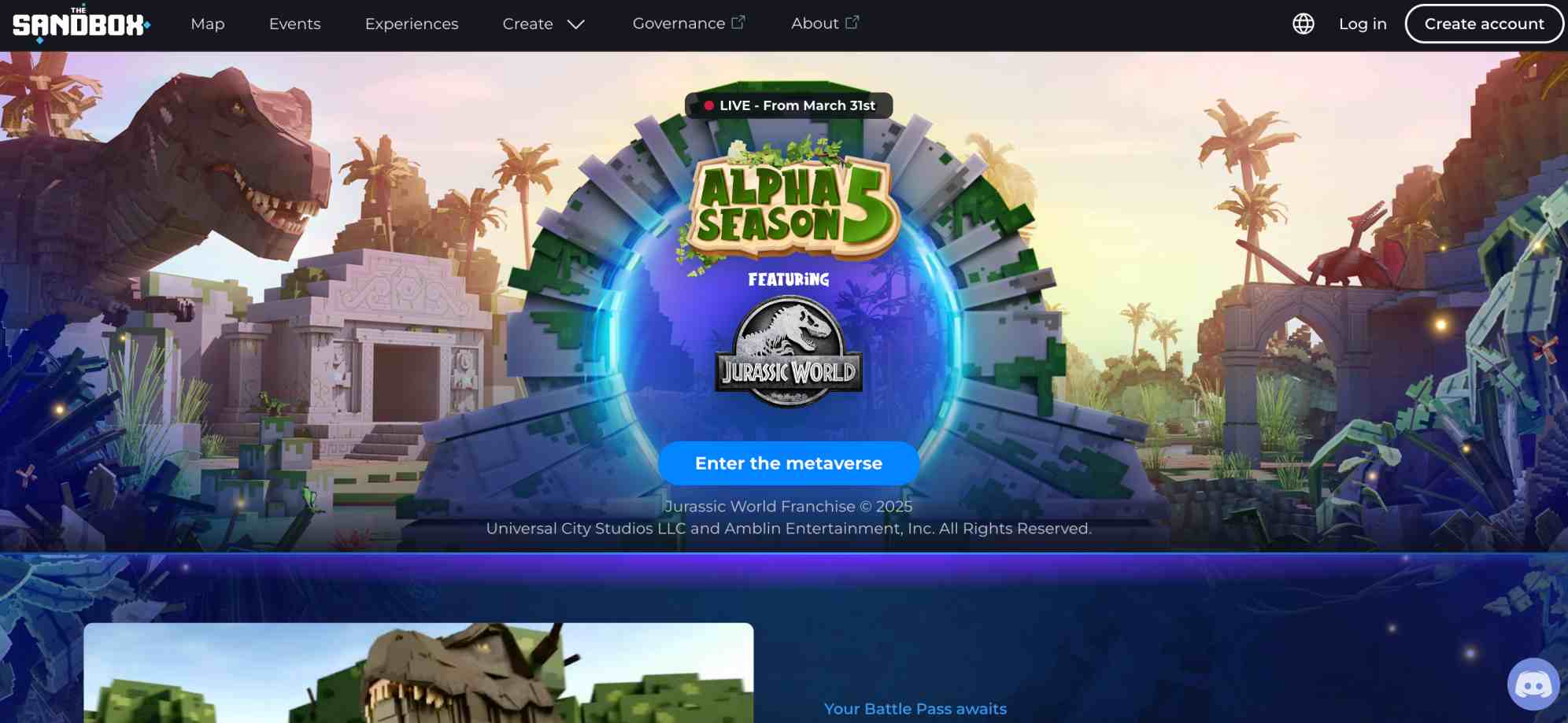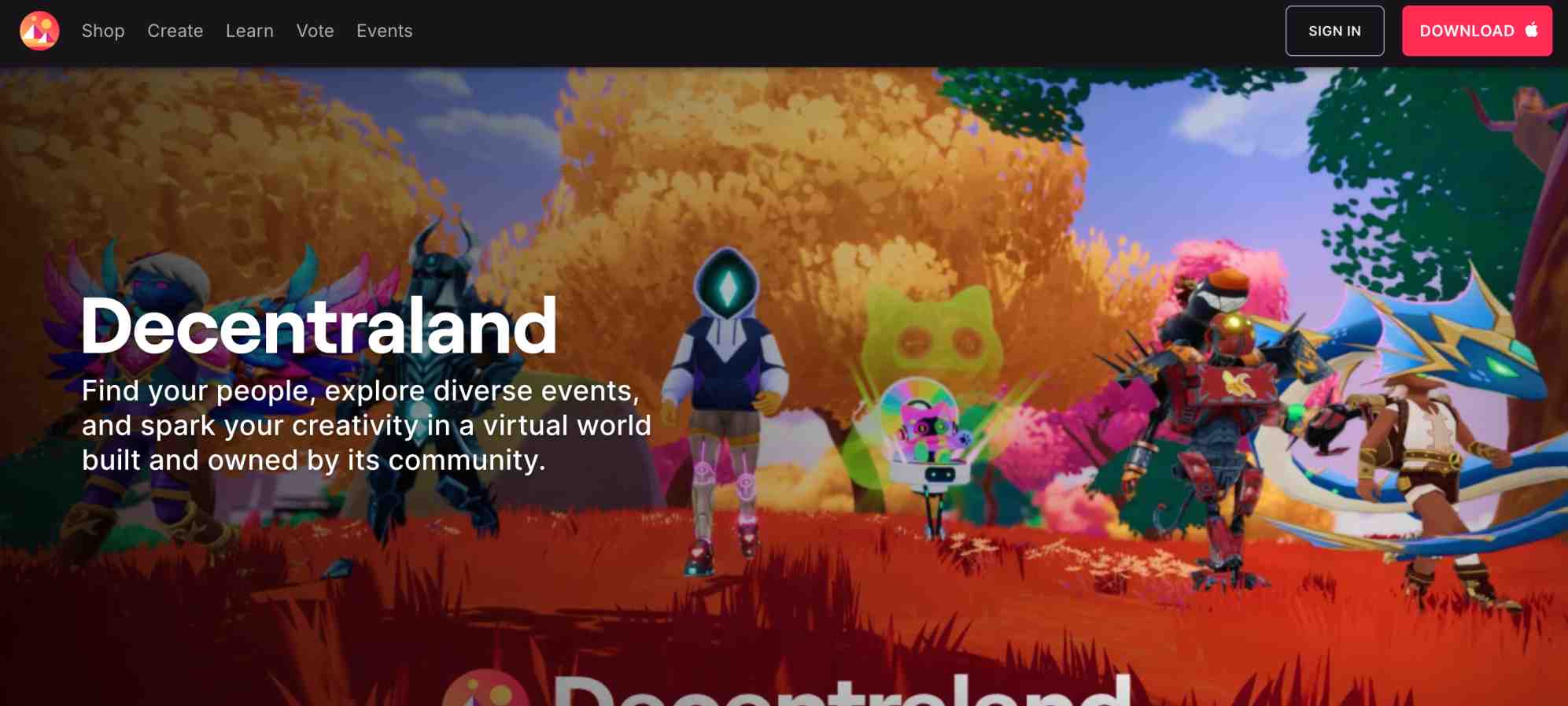On this Page:
Metaverses, also known as “virtual worlds,” will play a major role as we enter the Web 3.0 era. They will offer features including exclusive experiences like concerts and podcasts, gaming with play-to-earn rewards, and even real estate ownership.
Native cryptocurrencies facilitate transactions within each metaverse ecosystem and provide governance rights and monetization opportunities.
As a potentially undervalued market, we explore the best metaverse crypto to buy in 2025. Learn how metaverse coins work, what use cases and functions they provide, and whether they represent a viable long-term investment.
| # | Coin | Price | 24h % | Market Cap | Volume | 24h Range |
|---|---|---|---|---|---|---|
| 1 |
|
$0.0(4)80 | -4.88% | $773,656,206 | $80,107,491 |
$0.0(4)80
―
$0.0(4)84
|
| 2 |
|
$0.27 | -3.22% | $657,170,120 | $46,653,730 |
$0.27
―
$0.28
|
| 3 |
|
$0.28 | -1.87% | $521,575,558 | $24,329,896 |
$0.27
―
$0.28
|
| 4 |
|
$2.42 | -2.97% | $391,725,619 | $21,884,812 |
$2.42
―
$2.51
|
| 5 |
|
$0.39 | -3.88% | $197,108,356 | $3,439,825 |
$0.39
―
$0.41
|
| 6 |
|
$0.01 | -4.13% | $148,884,505 | $14,194,362 |
$0.01
―
$0.01
|
| 7 |
|
$12.43 | -3.77% | $117,369,820 | $13,531,738 |
$12.39
―
$12.92
|
| 8 |
|
$0.18 | -4.57% | $94,522,005 | $13,647,348 |
$0.18
―
$0.19
|
| 9 |
|
$0.20 | -3.16% | $63,874,072 | $491,932 |
$0.20
―
$0.21
|
| 10 |
|
$0.0(3)20 | -2.75% | $56,476,319 | $972,101 |
$0.0(3)20
―
$0.0(3)21
|
| 11 |
|
$0.41 | -2.68% | $37,691,967 | $8,923,911 |
$0.41
―
$0.42
|
| 12 |
|
$1.29 | -1.69% | $30,932,828 | $331,443 |
$1.28
―
$1.32
|
| 13 |
|
$0.0(4)72 | -0.55% | $29,816,481 | $4,738,254 |
$0.0(4)72
―
$0.0(4)74
|
| 14 |
|
$1.02 | 0.58% | $24,385,553 | $6,648,988 |
$1.01
―
$1.04
|
| 15 |
|
$0.0028 | -2.67% | $22,713,463 | $4,322,180 |
$0.0027
―
$0.0029
|
| 16 |
|
$0.38 | -6.02% | $19,460,865 | $5,300,550 |
$0.38
―
$0.41
|
FLOKI
FLOKIThe Sandbox
SANDDecentraland
MANAAxie Infinity
AXSOriginTrail
TRACXYO Network
XYOIlluvium
ILVYield Guild Games
YGGWilder World
WILDECOMI
OMIMy Neighbor Alice
ALICEEthernity Chain
ERNRadio Caca
RACAVulcan Forged
PYRVictoria VR
VRAavegotchi
GHSTTop Metaverse Coins in 2025
These are the five best metaverse cryptocurrencies. Read on to explore the top blockchain metaverse projects, including key features, tokenized utility, potential growth, and why we think they rule the metaverse.
1. Render ($RENDER)
Render Price Chart
(RENDER)Render (RENDER)
Render (RENDER) is one of the best long-term metaverse plays. It’s not an individual metaverse ecosystem but an important infrastructure for the broader industry. Render uses decentralization and blockchain to offer peer-to-peer GPU (graphics processing units) rendering.
Rendering is crucial for metaverse stakeholders – it’s required for creating immersive 3D models, avatars, animations, and games. Render’s peer-to-peer model allows anyone with excess GPU power to contribute resources to the network, earning $RENDER tokens for their efforts. Metaverse projects rent that GPU power, resulting in a sustainable and profitable ecosystem.
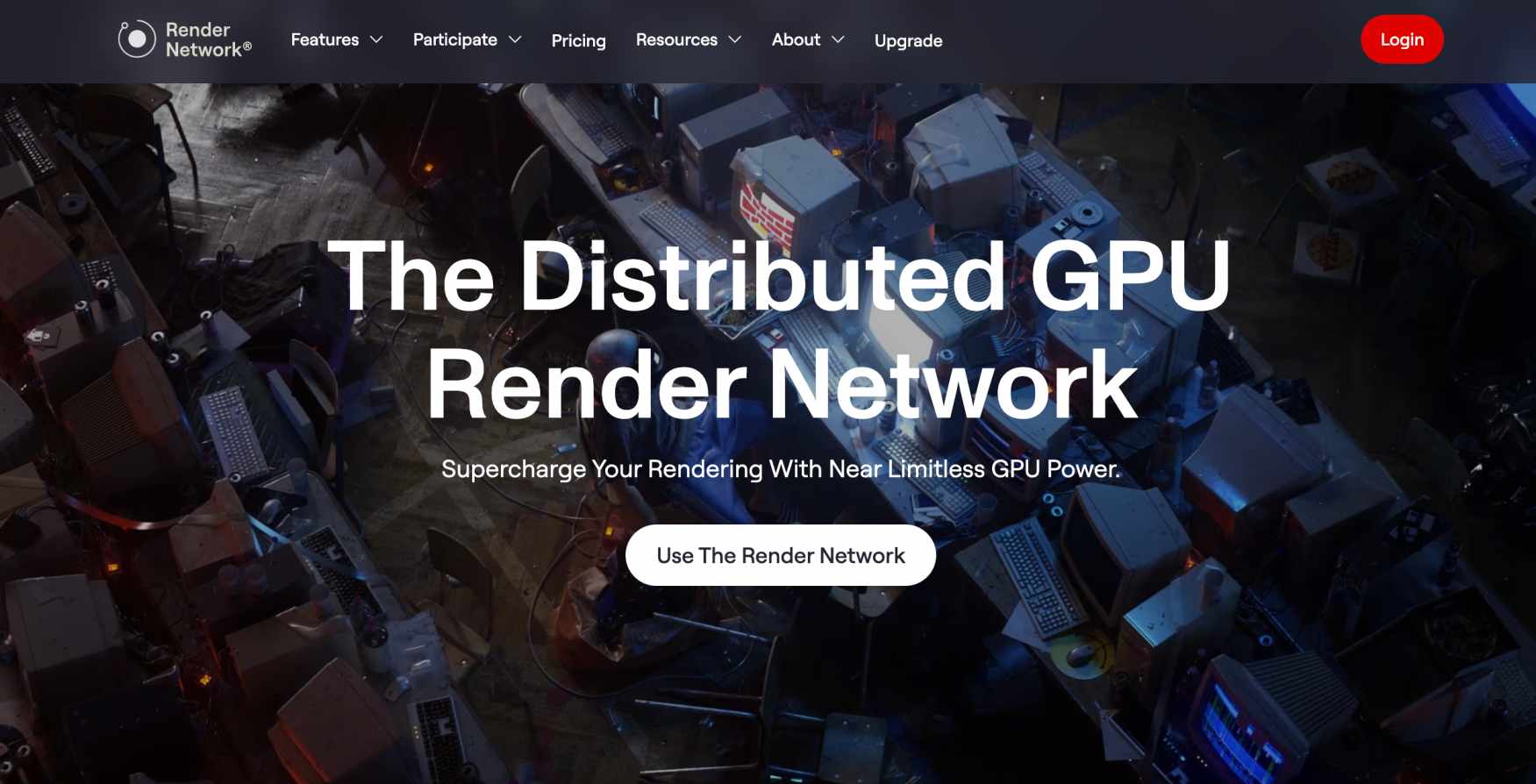
Render already integrates with popular 3D software tools, including Unreal Engine, Blender, and Cinema 4D – a huge advantage for metaverse developers seeking familiar interfaces. Ultimately, as consumers demand more realistic and interactive metaverses, alongside virtual reality experiences, Render provides the required computational power to realize these ambitions.
Find out more about Render
2. The Sandbox ($SAND)
The Sandbox Price Chart
(SAND)The Sandbox (SAND)
The Sandbox ($SAND) is a metaverse pure-play that provides direct exposure to an established virtual world and virtual assets. Built on Ethereum, It offers a wide range of metaverse experiences, including user-generated games. Most games are free, but some developers charge $SAND tokens for access.
Creators can also monetize by selling in-game digital assets or upgrades. The Sandbox is popular for exploring virtual neighborhoods and socializing with other users and, when using The Sandbox for the first time, custom avatars are created, reflecting the user’s online personality.
That said, The Sandbox is best known for its metaverse real estate concept. Users can purchase virtual land backed by NFTs on the Ethereum blockchain. Landowners can also build virtual buildings via a user-friendly toolkit, with popular creations including houses, condominiums, offices, casinos, and hotels.
$SAND tokens are used to buy and sell virtual land, with prices determined by market conditions, location, and size. Some plots have previously sold for several million dollars, although this was during the metaverse hype cycle in 2021. By extension, the $SAND price has since seen a major correction, potentially offering a more favorable valuation for new investors.
Find out more about The Sandbox
3. Floki ($FLOKI)
FLOKI Price Chart
(FLOKI)FLOKI (FLOKI)
Launched in 2021, Floki ($FLOKI) was initially designed as a meme coin without use cases or utility. It enjoyed a significant price rally post-launch, providing the Floki team with substantial resources and allowing them to build real value for token holders. Floki has since released “Valhalla,” a metaverse universe with play-to-earn gaming elements.
Valhalla offers open-world experiences, allowing players to explore and discover, build clans, and even enter battles. The latter uses a turn-based concept, with players needing strategic wit to outsmart their opponents. Once the Valhalla mainnet launches, players will earn $FLOKI tokens, with the team already allocating $50 million from the project treasury.
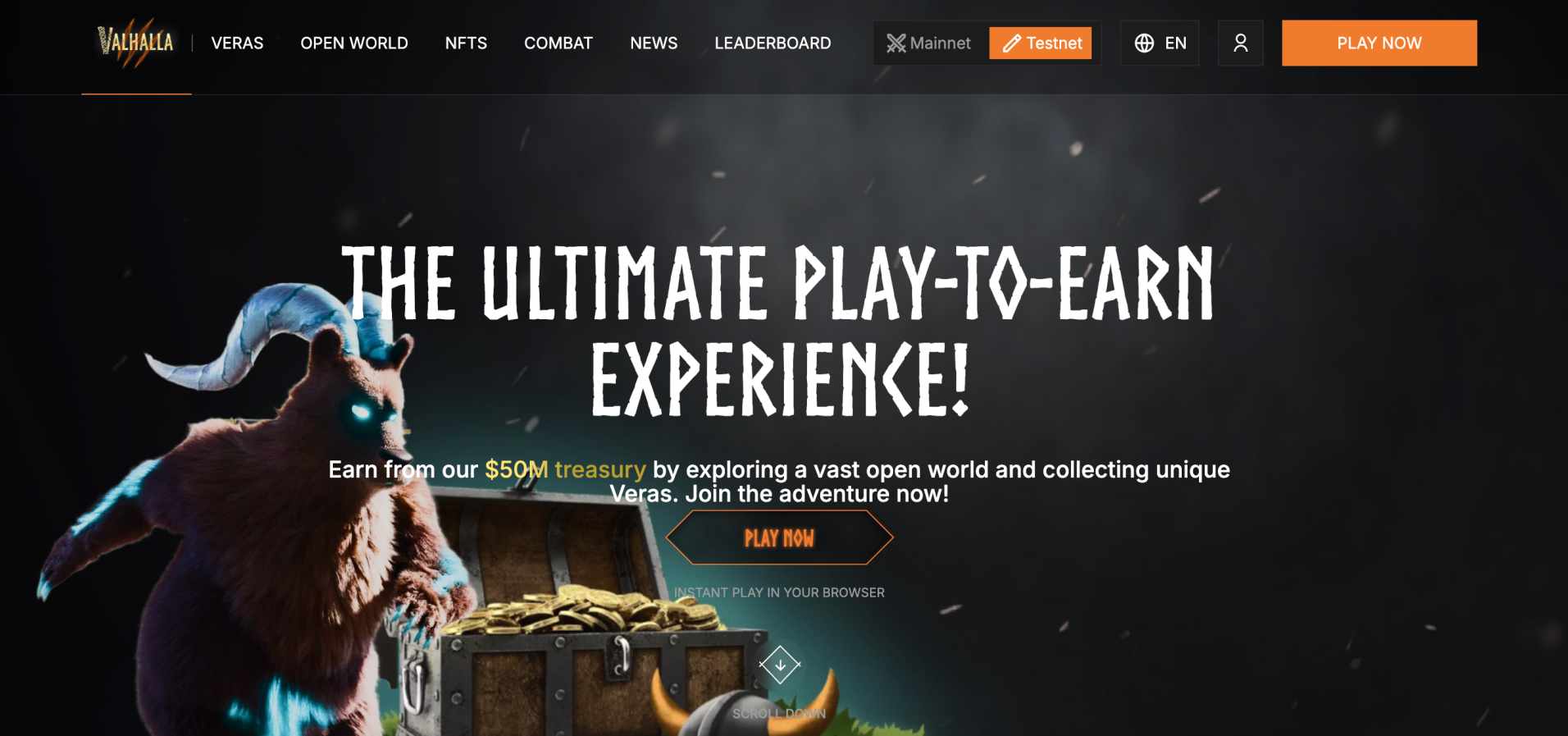
While Valhalla is free to play, in-game NFT purchases will enhance the gaming experience. This includes battle advantages like potions and access to exclusive metaverse areas. NFTs will also play a big role in metaverse land ownership, allowing players to build virtual assets on any purchased land. Potential valuations depend on how much demand the game enjoys.
$FLOKI tokens also provide exposure to other ecosystem features. One example is FlokiFi, a decentralized finance (DeFi) initiative, supporting staking and liquidity provision. There’s also Floki Card, a MasterCard-backed prepaid card with 0% transaction fees. Crucially, while Floki is one of the best metaverse cryptocurrencies, $FLOKI holders are diversified into several Web 3.0 niches.
Find out more about Floki
4. Axie Infinity ($AXS)
Axie Infinity Price Chart
(AXS)Axie Infinity (AXS)
Axie Infinity ($AXS) is a popular play-to-earn game that incorporates NFT ownership and metaverse elements. Players purchase “Axies” when starting, which are virtual creatures backed by unique NFTs. Each has varying traits, some rarer and more battle-ready than others. Axies compete in player-vs-player battles, with outcomes determined by stats like speed and skill, plus card-based strategy.
Players can win Smooth Love Potion ($SLP) tokens when competing in Ranked Arena mode. $SLP is one of two in-game currencies, and it’s now commonly used for breeding Axies. This means two compatible Axies create a new NFT creature, which can also be used for battles.
$AXS is considered the primary token, especially for investors seeking exposure to Axie Infinity’s growth. $AXS, used for staking and governance rights, also has a more sustainable token supply than $SLP. In terms of metaverse features, “Lunacia” allows players to explore new digital worlds, socialize, form guilds, and compete in challenges.
Metaverse land can also be purchased in Lunacia, allowing players to gather resources and host events. Future developments will enable custom buildings on virtual land plots, allowing for monetization opportunities.
Find out more about Axie Infinity
5. Decentraland ($MANA)
Decentraland Price Chart
(MANA)Decentraland (MANA)
Decentraland ($MANA) is a virtual metaverse world centered on customization. Players can explore user-generated content, from social hubs and art galleries to fully-fledged festivals. Mini-games are also available, some with play-to-earn rewards.
Players create custom avatars, with optional upgrades and apparel available via the online marketplace. Anyone can design and sell wearables, with sales conducted in $MANA tokens.
Decentraland also offers metaverse land ownership, with no limits on building virtual constructions. Land can be commercialized, such as selling tickets to a virtual gig or renting hotel rooms in a high-end neighborhood frequented by celebrities.
Decentraland plots have previously been purchased by recognizable brands like Samsung, UPS, Adidas, and PwC. Similar to The Sandbox, some Decentraland real estate investments have sold for over a million dollars.
However, Decentraland isn’t without its challenges, especially concerning land valuations. A broader dip in metaverse interest means that Decentraland plots are now worth a fraction of 2021 levels. There are also concerns about adoption rates, with unique daily active wallets now less than one hundred.
Find out more about Decentraland
Best Wallet - Diversify Your Crypto Portfolio
- Easy to Use, Feature-Driven Crypto Wallet
- Get Early Access to Upcoming Token ICOs
- Multi-Chain, Multi-Wallet, Non-Custodial
- Now On App Store, Google Play
- 250,000+ Monthly Active Users
What are Metaverse Coins?
The metaverse is a Web 3.0 concept focused on decentralized virtual worlds. While each metaverse project has its own ecosystem and use cases, many enable players to explore, socialize, play games, and build. Crypto coins are frequently used as the transactional currency, providing specific utility within the metaverse.
Metaverse users can purchase digital items, such as avatar wearables, access virtual experiences, and even own land plots. All purchases are backed by a non-fungible token (NFT) unique to the item. This ensures verifiable ownership on the blockchain and allows for trading NFTs.
A simple example is buying a metaverse land plot in The Sandbox, with valuations determined by the location and size. Similar to the traditional real estate market, that land plot can be sold based on its perceived value, with transactions conducted in the native crypto coin.
Metaverses have entire ecosystems with many ways to monetize items without listing them for sale. Somebody could build a virtual hotel in a high-end Decentraland neighborhood and earn $MANA tokens by renting out rooms.
Metaverse cryptocurrencies typically trade on public exchanges, meaning they’re also bought and sold for speculative reasons. Coins in this category saw significant growth during the prior bull market, with several projects achieving billion-dollar valuations. Metaverse land prices also rocketed, albeit the hype has since declined, meaning substantially reduced valuations.
What Are Metaverse Coins Used For?
The best metaverse cryptocurrencies offer many use cases, often within native ecosystems. Let’s explore their potential utility.
Transactional Currency
Metaverse worlds have proprietary cryptocurrencies for day-to-day transactions. They’re usually created on existing blockchains like Ethereum.
Metaverse coins are required when making ecosystem purchases, such as virtual land plots or avatar wearables. Similarly, anyone selling these items will also receive the metaverse coin as payment.
Gaming Rewards
Some metaverse projects double as play-to-earn games. Players are rewarded in native metaverse tokens based on performance, such as winning battles or completing tasks.
Rewards can then be used within the ecosystem or transferred to a crypto exchange to cash out, assuming sufficient liquidity.
Governance Rights
The best metaverse coins provide governance rights, giving holders a voice in key project decisions. While similar to owning shares in a public company, metaverse governance is considerably more democratic.
Votes should be conducted on any notable proposals, whether those are new features, supply dynamics, or partnerships.
Financial Speculation
Many investors buy metaverse cryptocurrencies for financial speculation. Prices rise and fall like any other crypto asset. However, investors heavily rely on broader metaverse sentiment.
Many metaverse coins produced unprecedented gains in 2021, when sentiment was at its highest. $SAND was worth about $0.03 in January 2021, rising to an all-time high of $8.44 by November. At its peak, a small outlay of $100 would have been worth over $20,000.
While metaverse hype has cooled off recently, some experts claim that prices are now more aligned with realistic valuations. This means first-time buyers can potentially enter this market at a more favorable price point.
How We Chose the Best Metaverse Cryptos
Many factors were considered when ranking the best metaverse crypto coins. Key metrics include practical use cases, adoption levels, key partnerships, and price potential.
Our research methods will now be discussed in more detail.
Practical Applications in the Metaverse
Our initial focus was on metaverse cryptocurrencies offering specific use cases. This can create organic demand over time, considering users must purchase the respective coin to access key features. Buying virtual real estate in The Sandbox, for instance, requires $SAND tokens. The same concept applies to Decentraland, with land plots bought and sold with $MANA.
Metaverse users also need tokens to construct virtual buildings, such as luxury villas, hotels, or casinos. They’re also used for custom wearables like hats, shirts, and glasses, and to access digital experiences. The latter could include an exclusive concert only available in the metaverse, with tickets purchased in the native coin.
Practical applications should also extend to governance. Decentralization is a key element of metaverse growth, with holders owning a small slice of their preferred ecosystem. Voting systems should be fair and proportionate, with results verifiable on the blockchain and honored based on the majority view.
User Base and Activity Levels
Like any community-driven ecosystem, metaverses can only survive with a sufficient user base. This means the metaverse should actually be participated in, not only by existing users but also new ones. A growing user base means increased adoption, leading to more transactions and demand for the native coin.
Higher adoption rates can also influence metaverse asset valuations. Metaverse plots, for example, are often finite, so prices can rise as demand increases.
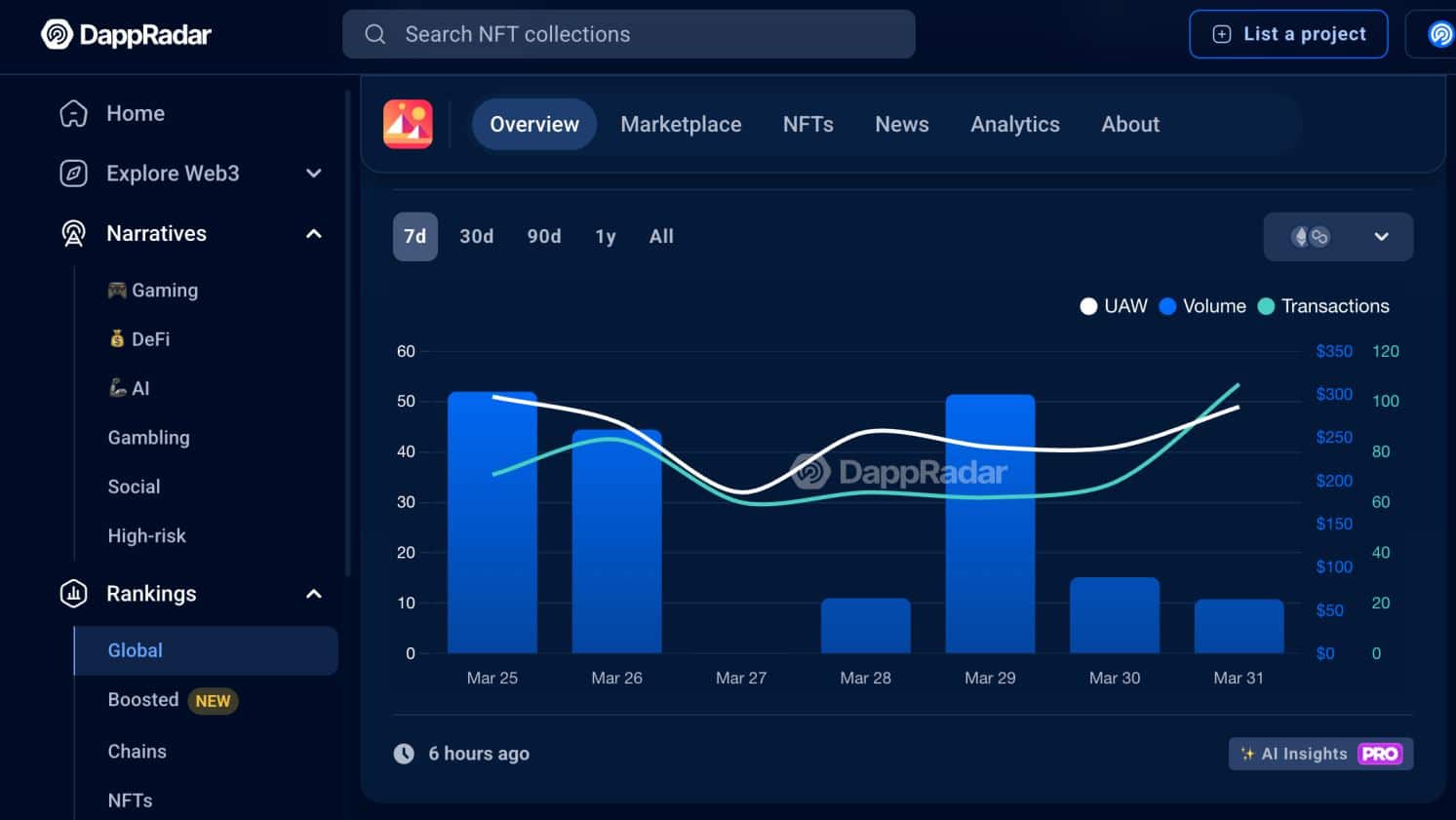
DappRadar is a good source for monitoring metaverse trends. It extracts data directly from the blockchain, ensuring validity. You can view the number of unique active wallets, incoming transactions, volume, and other core metrics. These trends are invaluable when selecting the best metaverse cryptocurrencies to invest in.
Market Performance
Market forces are the ultimate truth-tellers when evaluating metaverse coins. While broader metaverse sentiment will also play a role, analyzing price-performance metrics can yield important findings.
Using a benchmark figure is a good starting point. The “Metaverse Index” by Co-Op tracks the biggest metaverse tokens by market capitalization. It provides a broad overview of how the wider metaverse market is performing. Coins that consistently outperform this index illustrate strong sentiment.
It’s also wise to consider current pricing against all-time highs (ATH), most of which were achieved during the 2021 bull cycle. Investing in a metaverse project with strong fundamentals at an 80% ATH discount could provide an attractive risk-return ratio, especially if you’re bullish on the metaverse concept and expect a strong rebound in the long term.
Partnerships and Alliances
Partnerships and alliances with major brands are a stamp of approval for metaverse ecosystems. Decentraland has seen land purchases from many global companies, including Samsung, UPS, and Adidas. It has also hosted exclusive metaverse events. One notable case is PwC, which used its metaverse space to discuss climate and other social issues, with the digital and physical worlds getting closer than ever before.
Metaverses also receive widespread attention when celebrities get involved, often creating hype and FOMO, even in non-crypto markets. Snoop Dogg previously bought a virtual mansion in The Sandbox, with nearby plots seeing a rapid spike in valuations. One user paid over $450,000 to be Snoop Dogg’s metaverse neighbor.
Technological Advancements
One of the biggest challenges facing metaverses is a lack of immersion. Existing metaverses lack modern-day graphics and experiences, with limited support for virtual and augmented reality. This is why exploring technological advancements is crucial when choosing the best metaverse coins to buy.
The Web 3.0 markets strongly favor first-mover advantages, so the top metaverse projects are working hard to innovate. A good example is Render, which provides decentralized GPU rendering power to multiple industries, including metaverses. Developers can build more realistic and advanced virtual worlds, experiences, and games cost-effectively.
On the consumer-facing level, some metaverses are incorporating artificial intelligence (AI) into their frameworks. This could see AI-backed non-playable characters (NPCs) that adapt to individual users, getting smarter and more personable over time. In turn, the reliance on human-only socialization could decline.
Risks of Investing in Metaverse Crypto
Metaverse crypto coins could be a big growth market in the coming years, but several risks should be considered before proceeding. The most visible metaverse challenges are discussed below.
Ownership and Interoperability Issues
Each metaverse ecosystem is separate from the next, even when operating on the same blockchain. A good example is Axie Infinity and The Sandbox – both operate on Ethereum, yet there’s no interoperability between their metaverses.
The issue is that metaverse digital assets, including crypto coins, land plots, and virtual wearables, are only relevant within the respective ecosystem. You could risk $2,000 on a virtual hotel in The Sandbox only to see valuations drop if another metaverse takes off.
The long-term solution is interoperability, not only for metaverses on the same blockchain but also for other ecosystems, like Ethereum, Solana, and BNB Chain. This would enable cross-metaverse transactions, leading to broader adoption rates and larger communities.
Adoption and Sustainability Concerns
Another major challenge is adoption, meaning real people actively using metaverses, whether that’s to explore virtual worlds, socialize with like-minded users, or build real estate projects. A lack of adoption will have a negative impact on the metaverse’s native coin, considering limited transactional demand.
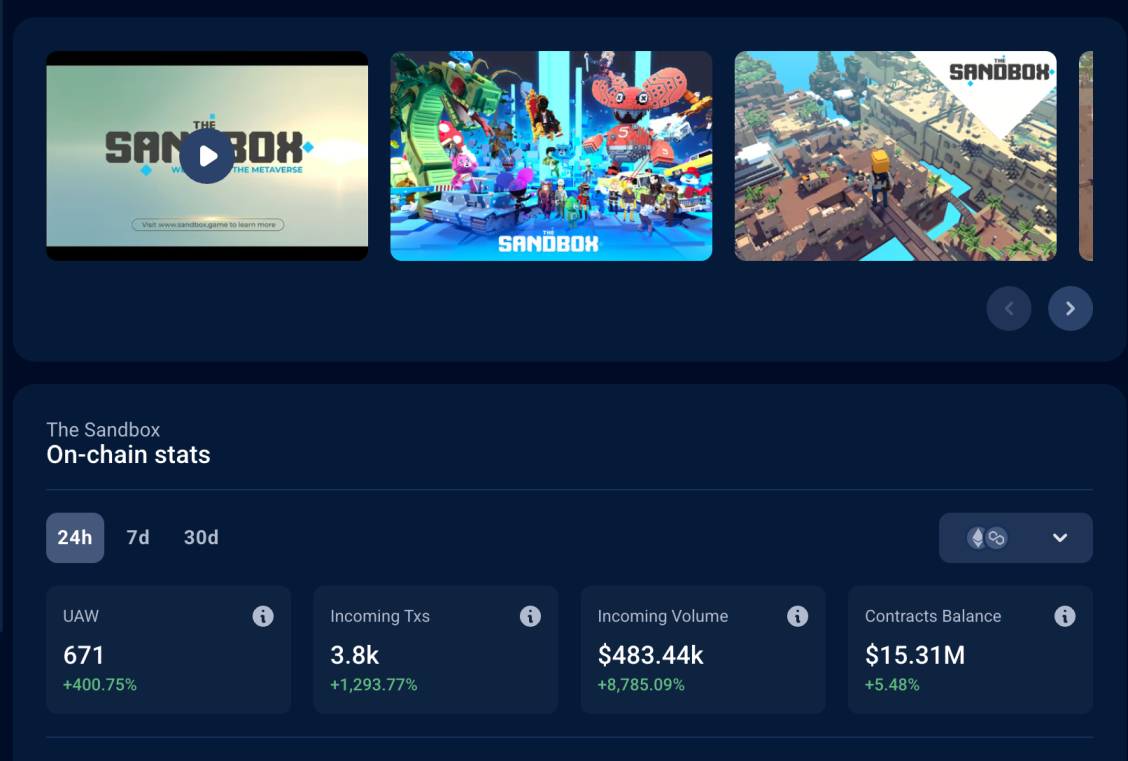
On-chain data suggests that adoption levels are now a fraction of previous highs. For example, The Sandbox saw just 671 unique active wallets in the past 24 hours, down significantly from over 7,000 during the hype cycle. This issue is further amplified when factoring in fragmentation. There’s a very limited pool of metaverse users in general, spread across multiple ecosystems. This reinforces the importance of interoperability, allowing broader metaverse communities to engage collectively.
Security Concerns
Metaverses are built on the blockchain, with smart contracts facilitating decentralized transactions. Smart contracts, while considered secure, aren’t 100% immune to hacks. This happens when there’s an exploitable vulnerability in the smart contract code.
Ronin Network, which is used by Axie Infinity, was previously hacked for over $600 million. While the native metaverse coin, $AXS, wasn’t directly targeted ($ETH and $USDC were stolen), it resulted in significant reputation damage. Transactions were temporarily frozen, too, meaning a loss of confidence from existing users. Not only was the $AXS price impacted, but so were ecosystem valuations, including Axies NFTs.
General security risks should also be considered when exploring the best metaverse crypto coins. Remote wallet hacks, for instance, lead to stolen funds, including any stored NFTs. The anonymous nature of the blockchain means that hacked digital assets are rarely recoverable, so wallet best practices should always be followed.
The Future of Metaverse Cryptocurrencies
The metaverse is a nascent market, so expect many developments in the coming years.
Integration With Traditional Industries
Long-term growth will require increased integration with traditional industries. We’ve seen early signs of established brands exploring the metaverse, including real land purchases with personalized experiences.
In the future, we could see more fashion brands offering metaverse-only products sold as limited-edition wearables. Similarly, major real estate companies could play a much bigger role in metaverse land, including virtual viewings and even mortgages.
Traditional workspaces will also be revolutionized. Office meetings could soon occur in the metaverse, with workers represented by their custom avatars. The possibilities are endless, but increased integration is crucial for long-term metaverse adoption.
Advancements in Virtual Reality (VR) and Augmented Reality (AR)
We mentioned earlier that existing metaverse experiences are subpar, including low-resolution graphics and limited 3D compatibility. The solution is virtual reality (VR) and augmented reality (AR). VR and AR headsets will take metaverse immersion to the next level.
Virtual real estate plots will suddenly appear like real-world buildings, fully explorable in a VR setting. Metaverse games and events will also be game-changers, evolving from flat on-screen experiences to real-life visualizations. However, virtual reality is in the early development phases, with low adoption numbers and a market that is still dominated by bulky headsets and poor battery lives.
Development of Interoperable Virtual Worlds
The ultimate solution for metaverse cryptocurrencies is complete interoperability. This will create a unified metaverse ecosystem, no matter the platform or blockchain standard. Instead of 10 metaverses each having 10,000 active users, interoperability increases this to a global community of 100,000 engaged participants.
Everyone benefits, with users accessing a much larger pool of like-minded people. Metaverse transactions will also rise. Greater choices when investing in real estate and collectibles mean increased demand for metaverse cryptocurrencies. Event hosts also benefit, with entertainers not siloed into one metaverse ecosystem.
However, blockchain technology must evolve before we see complete metaverse interoperability. While two Solana-based metaverses can engage, this isn’t as simple when different blockchains are involved. This is because each blockchain has its own technical framework, which is often not compatible with others.
Metaverse Cryptocurrency FAQs
Metaverse coins back virtual worlds like The Sandbox and Decentraland, facilitating transactions like land purchases. They can also provide governance and staking rights, ensuring a decentralized and democratic metaverse ecosystem.
Cryptocurrencies can power many metaverse functions, such as buying land plots, selling virtual experiences, and collecting wearables. They also support play-to-earn gaming rewards, governance participation, and speculative investing.
NFTs ensure metaverse digital assets, such as virtual real estate, are truly owned by users. They also enable open trading, creating a decentralized metaverse economy driven by demand and supply.
You can purchase metaverse coins on centralized exchanges like Binance, Kraken, and OKX. Some metaverse cryptocurrencies trade on decentralized exchanges too, offering an anonymous experience.
Yes, not only are cryptocurrencies inherently risky, but the metaverse concept is still unproven. Most metaverse coins will suffer if the concept doesn't achieve global adoption.
Metaverse cryptocurrencies are used to transact in virtual worlds, such as buying land and building real estate projects. That said, some people solely buy metaverse coins for speculative reasons, hoping their value will increase. What is a metaverse coin?
How do cryptocurrencies function within the metaverse?
What are non-fungible tokens (NFTs) in the metaverse?
How can you buy metaverse cryptocurrencies?
Are metaverse crypto investments risky?
What can you use metaverse crypto for?
References
- Billions being spent in metaverse land grab (BBC)
- A metaverse mogul is ready to make his move after buying $2 million in virtual land (CNBC)
- Getting to work in the metaverse (PwC)
- Why the metaverse still has mojo (McKinsey & Company)
- Someone just paid $450,000 to be Snoop Dogg’s neighbor in the metaverse. Here’s how you can live by a celebrity too (Fortune)
